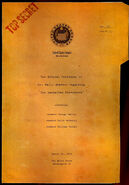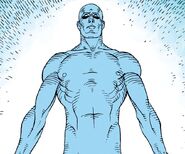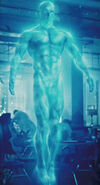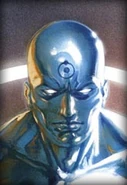Doctor Jonathan Osterman (born August 14, 1929), a.k.a. Doctor Manhattan is a main character in Watchmen.
Due to an accident involving a nuclear physics experiment, Dr. Osterman was taken outside the physical realm and returned with god-like powers, including superhuman strength, telekinesis, the ability to teleport himself or others over planetary, and interplanetary distances, control over matter at a subatomic level, near total clairvoyance. Furthermore, he perceives the past, present and future as happening simultaneously, but at least believes that he cannot act on that knowledge since his own actions and reactions to chronological events are apparently predetermined.
While his military backers market him as a superhero, he grows increasingly disinterested in human affairs, despite his importance in the Cold War, and is unable to connect with others (especially his love interest Laurie, the second Silk Spectre). Like most characters in Watchmen, Manhattan appears to have a personality disorder, in his case, Schizoid personality disorder which is characterized by reclusiveness and voluntary withdrawal from socializing to the detriment of personal relationships.
Biography
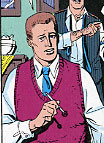
Young Jon Osterman
Doctor Manhattan was born Jonathan Osterman in 1929. His father was a watchmaker, and Jon planned to follow in his footsteps. When the US drops the atomic bomb on Hiroshima, Jon is sixteen. His father, confronted with the undeniable facts of the theory of relativity, declares his profession outdated and throws his son's watch-making parts out the windows, urging him to instead pursue a career studying nuclear physics. The incident represents the turning point in Jon's potential future from watchmaker to nuclear physicist and foreshadows Doctor Manhattan's 'exterior' perception of time as predetermined and all things within it as so determined, including Doctor Manhattan's own reactions and emotions.
Jon Osterman attends Princeton University from 1948-58 and graduates with a Ph.D. in atomic physics. In early 1959, he moves to a research base at Gila Flats, where experiments are being performed concerning the 'intrinsic fields' of physical objects which, if tampered with, result in their disintegration. Here he meets Janey Slater, a fellow researcher; they eventually become lovers.

Jon and Janey
During a trip to New Jersey in July 1959, Jon and Janey visit an amusement park. Janey's watchband breaks, and the watch is damaged when a fat man steps on it. Jon decides that he can repair the watch, and tells Janey so. That night they sleep together.
One month later, on August 20, 1959, shortly after his thirtieth birthday, Jon plans to give Janey the repaired watch, only to discover he has left it in his lab coat which is inside the intrinsic field experiment test chamber. While Jon is inside the test chamber retrieving his coat the door closes, automatically locking as a safety feature. Unable to open the door or override the countdown, Osterman's colleagues - save for Janey, who cannot bear to see the last moment and flees the room - can only watch, horrified, as the countdown for the current experiment shortly reaches zero, and Jon has his 'intrinsic field' removed. Bathed in the radiant light, he is torn to pieces from the force of the generator, instantly vaporized and officially declared dead.
Transformation

Jon appearance during its transformation
The following months see a series of strange events and apparitions at the research base, leading residents to speculate the area is now haunted. It becomes plain that Jon has been progressively reforming himself during this time. This progression being indicated by a series of partial bodily reappearances: first as a disembodied nervous system, including the brain and eyes; then as a circulatory system (November 10); then a screaming partially muscled skeleton (November 14). Each time, the appearance only lasts for a few seconds. Jon fully reappears on November 22 as a tall, hairless, naked, blue-skinned figure.
After his transformation, Jon begins to experience time in a non-linear, "quantum" fashion, and it is implied that he is aware of and experiencing all the moments of his life simultaneously. Jon is not omniscient; he remains reliant on his intellect and sensory experience to reach conclusions, but his range of sensory data has been abruptly extended, in proportion to the lessening of his emotional capacities. This often leads him to arrive at conclusions greatly different from those available to normal humans. However, during the course of Watchmen he displays powerful emotion several times. His apparent lack of sentiment is more a matter of radically altered priorities, owing to a colossal, unbridgeable gap of perception between Jon and the rest of humanity.
He subscribes to a deterministic view of events. During the period in which Doctor Manhattan is a crime-fighter (at the behest of the government), he states that the morality of such activities escapes him. From his radically altered perspective, almost all human concerns appear pointless and without obvious merit.
Effect on the Cold War
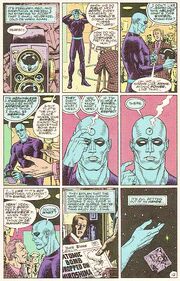
A new symbol
Jon gradually becomes a pawn of the United States government, though the means by which his loyalty is secured are never revealed; he is given the code name 'Doctor Manhattan', a reference to the Manhattan Project that, it is hoped, will defeat America's enemies. He is also provided with a costume which he grudgingly accepts, though he refuses to accept the icon design which is provided for him (this being a stylized orbital model of the atom). Instead, Jon chooses as his emblem a representation of a hydrogen atom, whose simplicity he declares to be something that kindles his respect; accordingly, he painlessly burns the mark into his forehead. This preference for material mechanisms marks the beginning of Jon's declining humanity, which is progressively mirrored by his gradual shedding of the uniform - by the end of the 1970s, he refuses to wear anything at all except for mandatory public appearances.
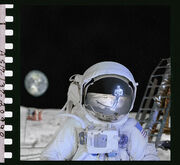
Dr Manhattan photographs Neil Armstrong on the occasion of the Apollo moon landings, July 20th 1969.
However, Jon's presence still succeeds in tipping the balance of the Cold War in the West's favor, and the United States consequently becomes more aggressive and adventurist during this period. His abilities also radically alter the world economy, as he can, for example, synthesize the massive amounts of lithium required for all motor vehicles to become electric. At President Richard Nixon's request, he brings America victory in the Vietnam war within three months. This victory distorts the American political process, as the 22nd Amendment is repealed and Nixon is then repeatedly reelected (and is still serving as of 1985, the year in which Watchmen is set, for what is theoretically his fifth term). Moreover, indications in the storyline suggest that, far from solving the problems underlying the international tension, Doctor Manhattan's presence in fact exacerbates them while stifling their expression, which inevitably builds towards disaster; the entire plot of Watchmen occurs during the countdown to a potential nuclear holocaust.
Exile and departure
During the first meeting of the Crimebusters superhero group, Laurie Juspeczyk, the second Silk Spectre, catches his eye. His relationship with Janey Slater ends acrimoniously shortly after, and he begins dating Laurie.
During the execution of Adrian Veidt's plot to save the world, Manhattan is accused of giving cancer to those exposed to him over long periods of time. It emerges that this is untrue, for it is rather a careful fabrication of Veidt's, but this revelation is not quick enough to prevent Manhattan from exiling himself to Mars, where he spends much of the action of Watchmen. Eventually, he brings Laurie (who, in the meantime, has taken Dan Dreiberg/Nite Owl II as a new lover) to Mars, where they argue over the fate of the human race.
Events of Watchmen
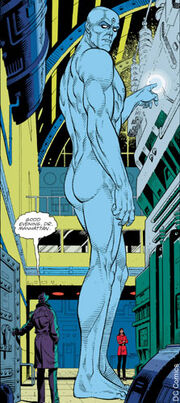
Rorschach meets a gigantic Dr. Manhattan
At the start of Watchmen, Doctor Manhattan is working in the Rockefeller Military Research Center for the U.S. government. He is living with the former Silk Spectre II, Laurie Juspeczyk.
It was there that Rorschach came to warn him and Laurie that the Comedian was dead, and all former costumed adventurers should watch out. John dismissed Rorschach by teleporting him out, and allowed Laurie to go out with Dan.
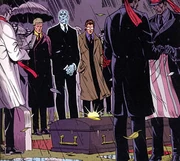
At The Comedian's funeral
Jon attended the Comedian's funeral and reflected on their association in the Vietnam War. He sensed Moloch's presence but he was not sure that he knew him once.
He appeared in Benny Anger's show where he would be interviewed. Agent Forbes briefed him on the politics of the Cold War that he might be asked upon. However it was not what Manhattan was there for. After Doug Roth's allegations that Manhattan causes cancer to humans, a fray erupted and the journalists came towards him asking for details concerning his relationship to Janey Slater. Forbes attempted to guide Manhattan outside and hold off the journalists. Eventually Manhattan teleported everyone away.

Reflecting on Mars
He leaves Earth for Mars when he is accused of causing cancer in his close associates over the years. However, this was a frame arranged by Veidt to induce Osterman to leave, to remove his interference in his scheme to save the world. Eventually, he brings Laurie to Mars to discuss why he should do anything to aid humanity, an argument Laurie inadvertently wins when she goes through her life and realizes to her shock that her father is the Comedian, a man whom she despised for sexually assaulting her mother. From that revelation, Doctor Manhattan is amazed by the improbable chances that occurred to result in the birth of Laurie, which he sees as a stunning "thermodynamic miracle." By extension, this miracle can apply to any living thing on Earth, and so Doctor Manhattan decides to return to Earth to protect humanity rather than disregarding it as insignificant.
Although they return too late to stop Veidt's plan, they teleport to Antarctica to confront him. Veidt hinders Doctor Manhattan with a tachyon generator that interferes with Doctor Manhattan's ability to see the future, and then disintegrates him by subtracting his intrinsic field. To Veidt's surprise, Doctor Manhattan restores himself much more quickly this time, but when Veidt reveals that his scheme, in which he used his alien monster to kill half of New York City, appears to have averted the looming nuclear war by frightening the world's governments into cooperation, Doctor Manhattan realizes that to expose the scheme would be too dangerous for all life on Earth. Doctor Manhattan and the other superheroes except for Rorschach agree to keep quiet to preserve Veidt's results. Rorschach leaves on his own and is murdered by Doctor Manhattan to prevent him from ever telling the truth. Manhattan does so reluctantly, at Rorschach's own insistence, who asserts that his death is the only thing that will ensure his silence. Doctor Manhattan does not mention Rorschach's death when talking to Veidt not long after, instead telling Veidt he "does not think Rorschach will reach civilization".
At the end of Watchmen, Doctor Manhattan decides to depart Earth again, but he might return one day. Veidt is surprised by his decision, pointing out the apparent contradiction with Doctor Manhattan's renewed interest in human life, to which Doctor Manhattan suggests that he may "create some [human life]" in another galaxy. When Veidt asks if his plan worked out in the end, Jon Osterman smiles and enigmatically replies that "nothing ever ends."
Powers and abilities
Jon is the only character in the Watchmen series to explicitly possess superhuman abilities (although the details of the plot presuppose the existence of genuine human psychics, cf. Robert Deschaines). Throughout Watchmen, he is shown to be immensely powerful and seemingly invulnerable to all harm; even when his body is disintegrated, he can reconstruct it from atoms (in less than a minute the second time this happened). Jon has complete awareness of and control over atomic and subatomic particles. He can alter his body's size, coloration, density, and strength. He does not need food, water, or air, and is, for all intents and purposes, immortal. He can teleport himself and others over great (even interplanetary and perhaps intergalactic) distances.
Jon's near-limitless powers are further amplified in comparison to the apparent lack of any other "super-powered" individuals. Although Veidt is obviously the second-most dangerous person, as Jon himself observes, "...the world's smartest man poses no more of a threat to me than does it's smartest termite."
In addition to these powers, Jon is able to phase any part of his body through solid objects without damaging them, produce multiple copies of himself which function independently of each other, project destructive energy, disintegrate people (possibly by removing their intrinsic fields, which causes the target to come apart explosively), create force fields, transmute and create matter, move objects without physically touching them (telekinesis), reverse entropy, and, he suggests, create life and walk on the surface of the sun. At one point it is stated that, in the event of a nuclear war, he would be capable of destroying upwards of 99% of all Soviet nuclear missiles while at the same time 'destroying' large areas of Russia. As a result of these capabilities, Jon becomes central to the United States' Cold War strategy of deterrence.
Due to his non-linear perception of time, he sees the past, present and future simultaneously, although he doesn't claim omniscience.
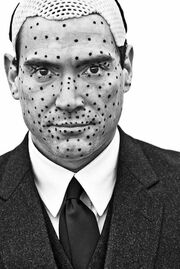
Watchmen Portraits - Doctor Manhattan
Limitations?
""We're all puppets, Laurie. I'm just a puppet who can see the strings."
—Jon to Laurie
A clear limit to his powers is never explicitly shown, however perhaps his biggest limitation appears to be apathy. In some sense, unlimited power has come at the cost of the total absence of responsibility, and his phenomenical omnipotence is juxtaposed with his growing detachment. Although he doesn't age in the biological sense, his character has changed over time with gradual detachment from humanity.
He subscribes to a deterministic view of events and exerts an effort of choice; his actions often seemed governed by a rigidly utilitarian code of ethics in which the correct course of action must be the one that benefits the most. From his radically altered perspective, almost all human concerns appear pointless and without obvious merit. For instance, he does nothing to prevent the assassination of President John F. Kennedy (even though he could see the future) or the murder of the Vietnamese woman, even though she was present.
He seems unable or unwilling to prevent the side effects others experience during teleportation; Laurie, for instance, always vomits on arrival, and when he teleported himself and her to Mars, he confessed that he "forgot" that Laurie can't breathe. Two of the rioters he teleported had heart attacks -- something Jon seems to dismiss in favor of having prevented a full-blown riot where more people would have been injured.
It was calculated that Jon could stop "only" 99% of the Soviet missiles and not all of them. However Adrian says that it's because he can't "Be everywhere at once."
It could be argued that he is not omniscient since at the Comedian's funeral he sees Moloch, wonders if this "thin man" is someone he knows, but does not recognize him; he states during an interview that he is only fully aware of his own future and existence, suggesting that he is not fully omnipotent as he cannot experience things that he will not learn on his own at some future date.
Weaknesses
Veidt was able to disintegrate him by subtracting Dr. Manhattan's intrinsic field, but even then he was able to reassemble himself in moments.
His only definite technical weakness appears to be tachyons; a large burst of them can 'jam' or slow his ability to see the future to a large extent, as well as temporarily confusing his perception of the "present time", but still his telekinetic powers were unaffected.
Note that tachyons exist only in theoretical physics, but in the Watchmen alternate history they have been already observed and manipulated by 1985.
Inspiration
Dr. Manhattan was created by Watchmen writer Alan Moore and artist Dave Gibbons but, like many main characters of the series, he is a modified version of a Charlton Comics character, in this case Captain Atom, created by Joe Gill and Steve Ditko.
The choice of the name Osterman for a crime fighter may be a deliberate joke, as Osterman is the original name of the Prince of Gangsters, "Monk" Eastman, a notorious Jewish gang leader from the Lower East Side.
In Watchmen: The Film Companion, Dr. Manhattan is described as an American patriot who willingly enters the service of his country to protect it. However the narrative of the comic and the film doesn't mention anything about his motives or beliefs concerning politics or the nation.
Film
Billy Crudup portrays the character in the film. He provided motion capture and plays Osterman as a human in the flashback scenes. Keanu Reeves was at one point rumored for the role, but backed out over contractual issues. When the project involved producer Joel Silver, Silver wanted to cast Arnold Schwarzenegger in the part [1].
In other media
- In Countdown: Arena #4, a white-skinned lookalike of Doctor Manhattan was one of the alternate versions of Monarch summoned to the multiverse arena. Like all the others, this version was killed and his power added to Monarch's.
- In Final Crisis #2, the exiled Monitor Nix Uotan sketches a character resembling Doctor Manhattan. Grant Morrison stated in an interview that the Final Crisis two-part series Superman: Beyond! will feature "Captain Atom from Earth 4, which is kind of a weird amalgam of the original Charlton universe and this kind of Watchmen parallel world."
- In Watchmen videos, Andrew Sheroke portrays Manhattan.
- In the film, his father was more supporting of him rather than opposing when working with watches.
References
- The Art of Brian Bolland (326 pages, Image Comics, November 2006, ISBN 1582406030)
- David Anthony Kraft's Comics Interview #65, 1988, interview with Moore and Gibbons (by Chris Sharrett)
Character gallery

